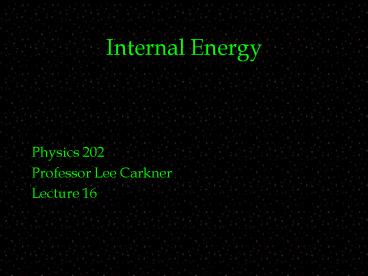Internal Energy
1 / 30
Title: Internal Energy
1
Internal Energy
- Physics 202
- Professor Lee Carkner
- Lecture 16
2
PAL 15 Kinetic Theory
- Which process is isothermal?
- Since T is constant, nRT is constant and thus pV
is constant - A is isothermal
- 3 moles at 2 m3, expand isothermally from 3500 Pa
to 2000 Pa - Need T, Vf
- Vf nRT/pf (3)(8.31)(281)/(2000) 3.5 m3
- Since T is constant, DE 0, Q W 3917 J
3
PAL 16 Internal Energy
- p,V and T for nitrogen
- Pressure increases (since lid pops off)
- Heat flow
- How do you find work?
- Assume all work is contained in lifting the lid
4
Ideal Gas
- We will approximate most gases as ideal gases
which can be represented by - vrms (3RT/M)½
5
Internal Energy
- We have looked at the work of an ideal gas, what
about the internal energy? - If the internal energy is the sum of the kinetic
energies of each molecule then - Eint (3/2) nRT
- Strictly true only for monatomic gasses
6
Molar Specific Heats
- How does heat affect an ideal gas?
- The equation for specific heat is
- From the first law of thermodynamics
- Consider a gas with constant V (W0),
- But DEint/DT (3/2)nR, so
- CV 3/2 R 12.5 J/mol K
7
Specific Heat and Internal Energy
- If CV (3/2)R we can find the internal energy in
terms of CV - Eint nCVT
- Change in internal energy depends only on the
change in temperature
8
Specific Heat at Constant Pressure
- We can also find the specific heat at constant
pressure - DEint Q - W
- Q nCpDT
- Solving for Cp we find
- Cp CV R
- Molar specific heat at constant pressure
9
Degrees of Freedom
- Our relation CV (3/2)R 12.5 agrees with
experiment only for monatomic gases - Kinetic energy
- For polyatomic gasses energy can also be stored
in modes of rotational motion
10
Rotational Motions
Polyatomic 2 Rotational Degrees of Freedom
Monatomic No Rotation
11
DegreesofFreedom
12
Equipartition of Energy
- Equipartition of Energy
- We can now write CV as
- CV f/2 R 4.16f J/mol K
13
Oscillation
- At high temperatures we also have oscillatory
motion - So there are 3 types of microscopic motion a
molecule can experience - If the gas gets too hot the molecules will
disassociate
14
Internal Energy of H2
15
Adiabatic Expansion
- Lets consider a process in which no heat transfer
takes place (adiabatic) - It can be shown that the pressure and temperature
are related by - where g Cp/CV
- You can also write
16
Isotherms
17
Isobaric Process
18
Summary Ideal Gas Processes
- Isothermal
- Constant temperature
- W nRTln(Vf/Vi)
- Isobaric
- Constant pressure
- WpDV
19
Adiabatic Process
20
IsochoricProcess
21
Ideal Gas Processes
- Adiabatic
- No heat (pVg constant, TVg-1 constant)
- W-DEint
- Isochoric
- Constant volume
- W 0
22
Four Thermodynamic Processes
23
P-V Diagram
Isobaric (pconst.)
p
Isothermal (Tconst)
Adiabatic (Q0)
Isochoric (Vconst)
V
24
Processes
- For each type of process you should know
- First law and ideal gas law always apply
25
The Arrow of Time
- If you see a film of shards of ceramic forming
themselves into a plate you know that the film is
running backwards - Examples
26
Entropy
- What do irreversible processes have in common?
- The degree of randomness of system is called
entropy
27
Determining Entropy
- In any thermodynamic process that proceeds from
an initial to a final point, the change in
entropy depends on the heat and temperature,
specifically
28
Isothermal Reversible Process
29
Isothermal Expansion
- Consider an example, isothermal expansion
- A cylinder of gas rests on a thermal reservoir
with a piston on top - The temperature is constant so
- DS Sf-Si(1/T)?dQ
30
Closed Systems
- Consider a closed system
- The entropy change in the gas is balanced by the
entropy change in the reservoir (DSQ/T)

